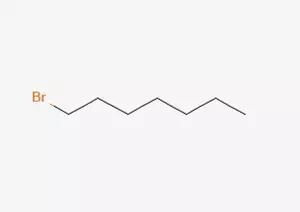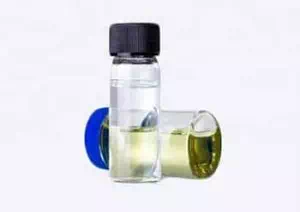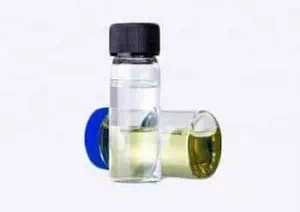1-Bromoheptane CAS 629-04-9 Information
Chemical Name | 1-Bromoheptane |
Other Name | 1-BroMo heptane; N-HEPTYL BROMIDE |
CAS | 629-04-9 |
EINECS | 211-068-8 |
Type | Organic raw materials |
Molecular Formula | C7H15Br |
Molecular Weight | 179.1 |

1-Bromoheptane CAS 629-04-9 properties
Melting point | −58 °C(lit.) |
Boiling point | 180 °C(lit.) |
density | 1.14 g/mL at 25 °C(lit.) |
vapor density | 6.18 (vs air) |
refractive index | n20/D 1.4499(lit.) |
Fp | 141 °F |
storage temp. | Sealed in dry,2-8°C |
solubility | 0.0066g/l |
form | Liquid |
color | Clear colorless to light yellow |
Water Solubility | insoluble |
What is 1-Bromoheptane CAS 629-04-9?
1-bromoheptane, under the conventional external environmental conditions of normal temperature and pressure, presents as a colorless, transparent or pale yellow liquid. In terms of solubility, it is insoluble in water, but it can dissolve in common organic solvents. In terms of its category, 1-bromoheptane belongs to the bromoalkane class of compounds. In the field of organic chemistry, it often plays an important role as an intermediate in the organic synthesis process. Its application is mainly reflected in organic synthesis, mainly for introducing a heptanyl unit into the structure of the target organic molecule, and it has considerable application value in the research of basic organic chemistry.
1-bromoheptane has a relatively low molecular weight, and its boiling point is also at a low level. The interaction forces between molecules are relatively weak. Generally speaking, the melting and boiling points of substances increase accordingly with the increase of molecular weight, and the case of 1-bromoheptane also conforms to this rule. From the perspective of molecular polarity, 1-bromoheptane belongs to nonpolar molecules. Since the electronegativity of bromine atoms is only slightly higher than that of carbon atoms, a dipole moment is formed between the main chain of bromine atoms and heptane. However, from the perspective of the entire molecule, its overall polarity is very small.
In its structural composition, bromine atoms have a good dissociation ability, and this characteristic enables it to participate in a variety of nucleophilic substitution reactions. With the help of these reactions, 1-bromoheptane can introduce a n-heptane group into the target molecule. Specifically, as long as the appropriate nucleophiles are carefully selected and the appropriate reaction conditions are set, the bromine atom in 1-bromoheptane May be replaced by other substituents, thereby successfully introducing the n-heptane group.
For example, in actual chemical reactions, alcohols can act as nucleophiles and undergo etherification reactions with 1-bromoheptane, thereby generating the corresponding n-heptanyl ether compounds; Or, amines can also act as nucleophiles and undergo substitution reactions with 1-bromoheptane, ultimately generating n-heptamine.

1-Bromoheptane CAS 629-04-9 Uses
In the vast field of organic chemistry, 1-bromoheptane holds a crucial position. As an indispensable important precursor material and intermediate in the fields of organic synthesis, medicine, and agricultural chemicals, it plays an extremely critical role.
In the complex system of organic synthesis, 1-bromoheptane is like a precise "building engineer", capable of ingeniously participating in various chemical reactions. It can be used as an introducing agent for heptanyl units, and this property gives it a unique advantage in constructing organic molecular structures. When it undergoes substitution reactions with other compounds, it is like a precise "key" that can accurately embed the hepyl unit into the structure of the target organic molecule.
The introduction of this Gene-based unit is by no means a simple structural superposition, but rather like a meticulously planned "molecular transformation". It will have a profound impact on the physicochemical properties of the target molecule, just like performing a subtle "modification surgery" on the molecule. On the one hand, it can increase the size of molecules and expand the original molecular structure in space, as if building a broader "framework" for molecules. On the other hand, it will also adjust the stereochemical properties of molecules, as if endowing molecules with a unique "spatial posture", enabling them to exhibit different characteristics in chemical reactions.
Not only that, 1-bromoheptane also has a subtle regulatory effect on the solubility and polarity of molecules and other properties. It is like a highly skilled "bartender", capable of precisely blending these properties of molecules based on specific reaction requirements, ensuring that the target molecules exhibit the most suitable state in various reaction environments. This lays a solid foundation for subsequent processes such as organic synthesis, pharmaceutical research and development, and the preparation of agricultural chemicals.
Service
* Prompt reply and 24 hours online, professional team to provide best price and high quality product.
* Sample testing support.
* Every batch of products will be tested to ensureits quality.
*The packing also can be according the customers` requirment.
*Any inquiries will be replied within 24 hours.
*we provide Commerical Invoice, Packing List, Bill of loading, COA , Health certificate and Origin certificate. If your markets have any special requirements, let us know.








